Understanding of the World
Understanding the world involves guiding children to make sense of their physical world and their community through opportunities to explore, observe and find out about people, places, technology and the environment.
Understanding the World is split into three aspects:
- Past and Present
- People, Culture and Communities
- The Natural World
with the following Early Learning Goals:
- Talk about the lives of the people around them and their roles in society.
- Know some similarities and differences between things in the past and now, drawing on their experiences and what has been read in class.
- Understand the past through settings, characters and events encountered in books read in class and storytelling.
- Describe their immediate environment using knowledge from observation, discussion, stories, non-fiction texts and maps.
- Know some similarities and differences between different religious and cultural communities in this country, drawing on their experiences and what has been read in class.
- Explain some similarities and differences between life in this country and life in other countries, drawing on knowledge from stories, nonfiction texts and (when appropriate) maps.
- Explore the natural world around them, making observations and drawing pictures of animals and plants.
- Know some similarities and differences between the natural world around them and contrasting environments, drawing on their experiences and what has been read in class.
- Understand some important processes and changes in the natural world around them, including the seasons and changing states of matter.
Early learning for children depends upon their sense of who they are and who is part of their personal world. We work with parents and families so that children understand about different cultures, beliefs and values. Children are encouraged to bring in photographs from home to share with the class. Learning opportunities help children develop a sense of self-worth; for example being ‘Child of the week’ sharing stories and role play opportunities using a variety of resources reflect the diversity of children’s experiences.
We explore the similarities, differences and features of the local environment; we take regular walks around the grounds to discover the seasonal changes, noting the spring blossom on the trees, the growing summer flowers and vegetables and the falling autumn leaves; we compare our own homes with those of others by strolling down the road and noting the different styles of buildings.
Additional learning opportunities include; providing stories that help children make sense of different environments; resources to create and explore maps and plans; well-equipped paintings, modelling and drawing areas for the construction of familiar and imaginary landscapes.
The children enjoy a range of activity toys and equipment with buttons and knobs for them to begin to understand the concept of cause and effect. Appliances such as vacuum cleaners, steam cleaners and CD players are also used in view of the children. They also have the use of a CD player to listen to stories and music; they use whisks during cooking activities and investigate the potential of torches when exploring the ‘dark dens’.
The children use our new school I-pads on a weekly basis and learn to navigate through programmes as they complete simple activities on the class interactive whiteboard.
